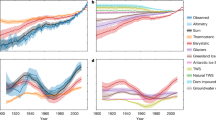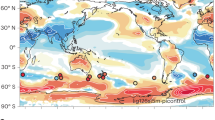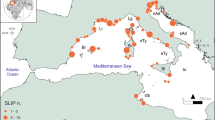Abstract
The oscillations between glacial and interglacial climate conditions over the past three million years have been characterized by a transfer of immense amounts of water between two of its largest reservoirs on Earth — the ice sheets and the oceans. Since the latest of these oscillations, the Last Glacial Maximum (between about 30,000 and 19,000 years ago), ∼50 million cubic kilometres of ice has melted from the land-based ice sheets, raising global sea level by ∼130 metres. Such rapid changes in sea level are part of a complex pattern of interactions between the atmosphere, oceans, ice sheets and solid earth, all of which have different response timescales. The trigger for the sea-level fluctuations most probably lies with changes in insolation, caused by astronomical forcing, but internal feedback cycles complicate the simple model of causes and effects.
This is a preview of subscription content, access via your institution
Access options
Subscribe to this journal
Receive 51 print issues and online access
$199.00 per year
only $3.90 per issue
Buy this article
- Purchase on Springer Link
- Instant access to full article PDF
Prices may be subject to local taxes which are calculated during checkout





Similar content being viewed by others
References
Mix, A. C. & Ruddiman, W. F. Oxygen isotope analyses and Pleistocene ice volumes. Quat. Res. 21, 1–20 (1984).
Shackleton, N. J. Oxygen isotope analyses and Pleistocene temperatures re-assessed. Nature 215, 15–17 (1967).
Raymo, M. E. in Start of a Glacial (eds Kukla, G. J. & Went, E.) 207–223 (Springer, Berlin, 1992).
Haug, G. H. & Tiedeman, R. Effect of the formation of the Isthmus of Panama on Atlantic Ocean thermohaline circulation. Nature 393, 673–676 (1998).
Shackleton, N. J. Oxygen isotope calibration of the onset of ice-rafting and history of glaciation in the North Atlantic region. Nature 307, 620–623 (1984).
Shackleton, N. J. & Opdyke, N. D. Oxygen isotope and palaeomagnetic stratigraphy of equatorial Pacific core V28-238: oxygen isotope temperatures and ice volumes on a 105 year scale and 106 year scale. Quat. Res. 3, 39–55 (1973).
Broecker, W. S. & van Donk, J. Insolation changes, ice volumes and the 18O record in deep-sea cores. Rev. Geophys. Space Phys. 8, 169–198 (1970).
Chappell, J. Geology of coral terraces, Huon Peninsula, New Guinea: a study of Quaternary tectonic movements and sea-level changes. Bull. Geol. Soc. Am. 85, 553–570 (1974).
Pirazolli, P. A. et al. Quaternary raised coral-reef terraces on Sumba Island, Indonesia. Science 252, 1834–1836 (1991).
Stirling, C. H. et al. Orbital forcing of the marine isotope stage 9 interglacial. Science 291, 290–293 (2001).
Broecker, W. S. & Denton, G. H. The role of ocean-atmosphere reorganizations in glacial cycles. Geochim. Cosmochim. Acta 53, 2465–2501(1989).
McManus, J. F., Oppo, D. W. & Cullen, J. L. A 0.5-million-year record of millennial-scale climate variability in the North Atlantic. Science 283, 971–975 (1999).
MacAyeal, D. R. Binge/purge oscillations of the Laurentide ice sheets as a cause of the North Atlantic's Heinrich events. Paleoceanography 8, 775–784 (1993).
Alley, R. B. & Clark, P. U. The deglaciation of the northern hemisphere: a global perspective. Annu. Rev. Earth Planet. Sci. 27, 149–182 (1999).
Hay, W. W. The cause of the Late Cenozoic Northern Hemisphere glaciations: a climate change enigma. Terra Nova 4, 305–311 (1992).
Berger, A. Milankovitch theory and climate. Rev. Geophys. 26, 624–657 (1988).
Emiliani, C. Pleistocene temperatures. J. Geol. 63, 538–578 (1955).
Hays, J. D., Imbrie, J. & Shackleton, N. J. Variations in the earth's orbit: pacemaker of the ice ages. Science 194, 1121–1132 (1976).
Duplessy, J. C., Chenouard, L. & Villa, F. Weyl's theory of glaciation supported by isotopic study of Norwegian core K11. Science 188, 1208–1209 (1975).
Imbrie, J. et al. On the structure and origin of major glaciation cycles, 2. The 100,000-year cycle. Paleoceanography 8, 699–735 (1993).
Berger, A, Loutre, M. F. Lascar, J. Stability of the astronomical frequencies over the earth's history for paleoclimate studies. Science 255, 560–566 (1992).
Imbrie, J. et al. On the structure and origin of major glaciation cycles, 1. Linear responses to Milankovitch forcing. Paleoceanography 7, 701–738 (1992).
Imbrie, J., Berger, A. & Shackleton, N. J. in Global Changes in the Perspective of the Past (eds Eddy, J. A. & Oescher, H.) 263–277 (Wiley, Chichester, 1993).
Imbrie, J. & Imbrie, J. Z. Modelling the climatic responses to orbital variations. Science 207, 943–953 (1980).
Clark, P. U. & Pollard, D. Origin of the middle Pleistocene transition by ice sheet erosion of regolith. Paleoceanography 13, 1–9 (1998).
Muller, R. A. & MacDonald, G. J. F. Glacial cycles and astronomical forcing. Science 277, 215–218 (1997).
Shackleton, N. J. The 100,000-year ice-age cycle identified and found to lag temperature, carbon dioxide, and orbital eccentricity. Science 289, 1897–1902 (2000).
Gallup, C. D., Edwards, R. L. & Johnson, R. G. The timing of high sea levels over the past 200,000 years. Science 263, 796–800 (1994).
Bard, E., Antonioli, F. & Silenzi, S. Duration and timing of the penultimate interglacial sea level highstand: implications for the astronomical theory of palaeoclimate. Earth Planet. Sci. Lett. 196, 135–146 (2002).
Galewsky, J., Silver, E. A., Gallup, C. D., Edwards, R. L. & Potts, D. C., Foredeep tectonics and carbonate platform dynamics in the Huon Gulf, Papua New Guinea. Geology 24, 819–822 (1996).
Stirling, C. H., Esat, T. M., Lambeck, K. & McCulloch, M. T. Timing and duration of the Last Interglacial: evidence for a restricted interval of widespread coral reef growth. Earth Planet. Sci. Lett. 160, 745–762 (1998).
Rohling, E. J. et al. Magnitudes of the sea-level lowstands of the past 500,000 years. Nature 394, 162–165 (1998).
Ferland, M. A., Roy, P. S. & Murray-Wallace, C. V. Glacial lowstand deposits on the outer continental shelf of southeastern Australia. Quat. Res. 44, 294–299 (1995).
Chappell, J. & Shackleton, N. J. Oxygen isotopes and sea level. Nature 324, 137–140 (1986).
Mesolella, K., Matthews, R. K., Broecker, W. S. & Thurber, D. L. The astronomical theory of climate change: Barbados data. J. Geol. 77, 250–274 (1969).
Chappell, J. et al. Reconciliation of late Quaternary sea levels derived from coral terraces at Huon Peninsula with deep sea oxygen isotope records. Earth Planet. Sci. Lett. 141, 227–236 (1996).
Esat, T. M., McCulloch, M. T., Chappell, J., Pillans, B. & Omura, A. Rapid fluctuations in sea level recorded at Huon Peninsula during the Penultimate Deglaciation. Science 283, 197–201 (1999).
Yokoyama, Y., Esat, T. M., Lambeck, K. & Fifield, L. K. Last ice age millennial scale climate changes recorded in Huon Peninsula corals. Radiocarbon 42, 383–401 (2000).
Stein, M. et al. TIMS U-series dating and stable isotopes of the last interglacial event in Papua New Guinea. Geochim. Cosmochim. Acta 57, 2541–2554 (1993).
Lambeck, K. & Chappell, J. Sea level change through the last glacial cycle. Science 292, 679–686 (2001).
Yokoyama, Y., Esat, T. M. & Lambeck, K. Coupled climate and sea-level changes deduced from Huon Peninsula coral terraces of the last ice age. Earth Planet. Sci. Lett. 193, 579–587 (2001).
Chappell, J. C. Sea-level changes forced ice breakouts in the Last Glacial cycle: new results from coral terraces. Quat. Sci. Rev. 21, 1229–1240 (2002).
Imbrie, J. et al. in Milankovitch and Climate (eds Berger, A. et al.) 269–305 (Reidel, Dordrecht, 1984).
Lambeck, K. & Nakada, M. Constraints on the age and duration of the last interglacial period and on sea-level variations. Nature 357, 125–128 (1992).
Potter, E.-K. et al. Timing and magnitude of oxygen isotope stage 5a and 5c sea level oscillations at Barbados: implications for the melting history of the Laurentide ice sheet during OIS 5 and 6. Eos Trans. AGU 82(47), Fall Meet. Suppl., Abstract PP12A-0467 (2001).
Gallup, C. D., Cheng, H., Taylor, F. W. & Edwards, R. L. Direct determination of the timing of sea level change during termination II. Science 295, 310–313 (2002).
Winograd, I. J. et al. Continuous 500,000 year climate record from vein calcite in Devils Hole, Nevada. Science 258, 255–260 (1992).
Henderson, G. M. & Slowey, N. C., Evidence from U-Th dating against northern hemisphere forcing of the penultimate deglaciation. Nature 404, 61–65 (2000).
Ludwig, K. R. et al. Sea level records at ∼80ka from tectonically stable platforms: Florida and Bermuda. Geology 24, 211–214 (1996).
Toscano, M. A. & Lundberg, J. Submerged Late Pleistocene reefs on the tectonically-stable S.E. Florida margin: high-precision geochronology, stratigraphy, resolution of Substage 5a sea-level elevation, and orbital forcing. Quat. Sci. Rev. 18, 753–767 (1999).
Denton, G. H. & Hughes, T. J. (eds) The Last Great Ice Sheets (Wiley, New York, 1980).
Lundqvist, J. in Glacial Stratigraphy, Engineering Geology and Earth Construction (ed. Kauranne, K.) (Geol. Surv. Finland Special Paper 15) 43–59 (Geol. Surv. Finland, 1992).
Helmens, K. F., Räsänen, M. E., Johansson, P. W., Jungner, H. & Korjonen, K. The last interglacial-glacial cycle in NE Scandinavia: a nearly continuous record from Sokli (Finnish Lapland). Quat. Sci. Rev. 19, 1605–1623 (2000).
Mangerud, J. Ice sheet limits in Norway and on the Norwegian continental shelf. Quat. Sci. Rev. (submitted).
Svendsen, J. I. et al. Maximum extent of the Eurasian ice sheets in the Barents and Kara Sea region during the Weichselian. Boreas 28, 234–242 (1999).
Clark, P. U. et al. Initiation and development of the Laurentide and Cordilleran ice sheets following the Last Interglaciation, Quat. Sci. Rev. 12, 79–114 (1993).
Lund, D. C. & Mix, A. C. Millennial-scale deep water oscillations: reflections of the North Atlantic in the deep Pacific from 10 to 60 ka. Paleoceanography 13, 10–19 (1998).
Bond, G. et al. Evidence for massive discharges of icebergs into the North Atlantic ocean during the last glacial period. Nature 360, 245–249 (1992).
Bond, G. et al. Correlations between climate records from North Atlantic sediments and Greenland ice. Nature 365,143–147 (1993).
Kanfoush, S. L. et al. Millennial-scale instability of the Antarctic ice sheet during the last glaciation, Science 288, 1815–1818 (2000).
Heinrich, H. Origin and consequences of cyclic ice rafting in the northeast Atlantic Ocean during the last 130,000 years. Quat. Res. 29, 143–152 (1988).
Chapman, M. R., Shackleton, N. J. & Duplessey, J.-C., Sea surface temperature variability during the last glacial-interglacial cycle assessing the magnitude and pattern of climate change in the North Atlantic. Palaeogeogr. Palaeoclimatol. Palaeoecol. 157, 1–25 (2000).
Broecker, W. S. Massive iceberg discharges as triggers for global climate change. Nature 372, 421–424 (1994).
Fawcett, P. J., Agustsdottir, A. M., Alley, R. B. & Shuman, C. A. The Younger Dryas termination and the North Atlantic deep water formation: insights from climate model simulations and Greenland ice cores. Paleoceanography 12, 23–38 (1997).
Alley, R. B. Icing the North Atlantic. Nature 392, 335–337 (1998).
Kitagawa, H. & van der Plicht, J., Atmospheric radiocarbon calibration to 45,000 yr B.P.: late glacial fluctuations and cosmogenic isotope production. Science 279, 1187–1190 (1998).
Hughen, K. A., Southon, J. R., Lehman, S. J. & Overpeck, J. T. Synchronous radiocarbon and climate shifts during the last deglaciation. Science 290, 1951–1954 (2000).
Broecker, W. S. & Hemming, S. Climate swings come into focus. Science 294, 2308–2309 (2001).
Dowdeswell, J. A., Elverhøi, A., Andrews, J. T. & Hebbeln, D. Asynchronous deposition of ice-rafted layers in the Nordic seas and North Atlantic Ocean. Nature 400, 348–351 (1999).
Shemesh, A., Burckle, L. H. & Hays, J. D. Meltwater input to the Southern Ocean during the Last Glacial Maximum. Science 266, 1542–1544 (1994).
Bond, G. C. & Lotti, R. Iceberg discharges into the North Atlantic on millennial time scales during the Last Glaciation. Science 267, 1005–1010 (1995).
Mix, A. C., Bard, E. & Schneider, R. Environmental processes of the ice age land, oceans, glaciers (EPILOG). Quat. Sci. Rev. 20, 627–657 (2001).
Yokoyama, Y., Lambeck, K., De Deckker, P., Johnston, P. & Fifield, L. K. Timing of the Last Glacial Maximum from observed sea-level minima. Nature 406, 713–716 (2000). [Published correction in Nature, 412, 99 (2001).]
Milne, G. A., Mitrovica, J. X. & Schrag, D. P. Estimating past continental ice volume from sea-level data. Quat. Sci. Rev. 21, 361–376 (2002).
Lambeck, K., Yokoyama, Y. & Purcell, A., Into and out of the Last Glacial Maximum: sea-level change during oxygen isotope stages 3 and 2. Quat. Sci. Rev. 21, 343–360 (2002).
Olsen, L., Sveian, H. & Bergstrøm, B. Rapid adjustments of the western part of the Scandinavian ice sheet during the Mid and Late Weichselian—a new model. Norw. J. Geol. 81, 93–118 (2001).
Sejrup, H. P. et al. Quaternary glaciations in southern Fennoscandia: evidence from southwestern Norway and the northern North Sea. Quat. Sci. Rev. 19, 667–685 (2000).
Ukkonen, P., Lunkka, J. P., Jungner, H. & Donner, J. New radiocarbon dates from Finnish mammoths indicating large ice-free areas in Fennoscandia during the Middle Weichselian. J. Quat. Sci. 14, 711–714 (1999).
Tushingham, A. M. & Peltier, W. R. ICE-3G: a new global model of Late Pleistocene deglaciation based upon geophysical predictions of postglacial sea-level change. J. Geophys. Res. 96, 4497–4523 (1991).
Lambeck, K., Smither, C. & Johnston, P. Sea-level change, glacial rebound and mantle viscosity for northern Europe. Geophys. J. Int. 134, 647–651 (1998).
Vorren, T. O., Vorren, K.-D., Alm, T., Gullimsen, S. & Løvlie, R. The last deglaciation (20,000–11,000 B.P.) on Andøya, northern Norway. Boreas 17, 41–77 (1988).
Licciardi, J. M., Clark, P. U., Jenson, J. W. & MacAyeal, D. R. Deglaciation of a soft-bed Laurentide ice sheet. Quat. Sci. Rev. 17, 427–448 (1998).
Miller, G. H. et al. The Goldilocks dilemma: big ice, little ice, or “just-right” ice in the Eastern Canadian Arctic. Quat. Sci. Rev. 21, 33–48 (2002).
Lambeck, K. Limits on the areal extent of the Barents Sea ice sheet in Late Weichselian time. Palaeogeogr. Palaeoclimatol. Palaeoecol. 12, 41–51 (1996).
Bennike, O., Björck, S. & Lambeck, K. Estimates of South Greenland late-glacial ice limits from a new relative sea level curve. Earth Planet. Sci. Lett. 197, 171–186 (2002).
Zwartz D., Bird, M., Stone, J. & Lambeck, K. Holocene sea-level change and ice-sheet history in the Vestfolf Hills, East Antarctica. Earth Planet. Sci. Lett. 155, 131–145 (1998).
CLIMAP Project Members. The surface of the ice age Earth. Science 191, 1131–1137 (1976).
Lambeck, K., Yokoyama, Y., Johnston, P. & Purcell, A. Global ice volumes at the Last Glacial Maximum and early Late glacial. Earth Planet. Sci. Lett. 181, 513–527 (2000).
Elliot, M. et al. Millennial-scale iceberg discharges in the Irminger Basin during the last glacial period: relationship with the Heinrich events and environmental settings. Paleoceanography 13, 433–446 (1998).
Shemesh, A., Burckle, L. H. & Hays, J. D. Meltwater input to the Southern Ocean during the Last Glacial Maximum. Science 266, 1542–1544 (1994).
Petit, J. R. et al. Climate and atmospheric history of the past 420,000 years from the Vostok ice core, Antarctica. Nature 399, 429–436 (1999).
Stoffers, P. & Ross, D. A. Late Pleistocene and Holocene sedimentation in the Persian Gulf-Gulf of Oman. Sedim. Geol. 23, 181–208 (1979).
Fairbanks, R. G. A 17,000-year glacio-eustatic sea level record: influence of glacial melting rates on the Younger Dryas event and deep-ocean circulation. Nature 342, 637–642 (1989).
Bard, E., Hamelin, B. & Fairbanks, R. G. U-Th ages obtained by mass spectrometry in corals from Barbados: sea level during the past 130,000 years. Nature 346, 456–458 (1990).
Bard, E. et al. Deglacial sea-level record from Tahiti corals and the timing of global meltwater discharge. Nature 382, 241–244 (1996).
Hanebuth, T., Stattegger, K. & Grootes, P. M. Rapid flooding of the Sunda Shelf: a late-glacial sea-level record. Science 288, 1033–1035 (2000).
Clark, P. U. et al. Origin of the first global meltwater pulse following the last glacial maximum. Paleoceanography 11, 563–577 (1996).
Clark, P. U., Mitrovica, J. X., Milne, G. A. & Tamisiea, M. E. Sea-level fingerprinting as a direct test for the source of global meltwater pulse IA. Science 295, 2438–2441 (2002).
Johnson, R. G. Major northern hemisphere deglaciation caused by a moisture deficit 140 ka. Geology 19, 686–689 (1991).
Shaffer, J. A., Cerveny, R. S. & Dom, R. I. Radiation windows as indicators of an astronomical influence on the Devil's Hole chronology. Geology 24, 1017–1020 (1996).
Acknowledgements
This research was supported by the Australian National University and by the Swedish Research Council. We thank S. Björck for constructive comments and M. E. Raymo and G. H. Haug for providing the data sets for Fig. 1.
Author information
Authors and Affiliations
Rights and permissions
About this article
Cite this article
Lambeck, K., Esat, T. & Potter, EK. Links between climate and sea levels for the past three million years. Nature 419, 199–206 (2002). https://doi.org/10.1038/nature01089
Issue Date:
DOI: https://doi.org/10.1038/nature01089
This article is cited by
-
Genetic analyses reveal panmixia in Indian waters and population subdivision across Indian Ocean and Indo-Malay Archipelago for Decapterus russelli
Scientific Reports (2023)
-
Deglacial perspectives of future sea level for Singapore
Communications Earth & Environment (2023)
-
Non-linear interactions between tides and storm surges during extreme weather events over the eastern Canadian shelf
Ocean Dynamics (2023)
-
Genetic structure of the threatened Gray Parrotfish (Sparisoma axillare) in the Southwestern Atlantic
Coral Reefs (2023)
-
Ecotypic differentiation in populations of Brazilian coast: recognizing adaptation to temperature in Gracilariopsis tenuifrons (Gracilariales, Rhodophyta)
Journal of Applied Phycology (2022)
Comments
By submitting a comment you agree to abide by our Terms and Community Guidelines. If you find something abusive or that does not comply with our terms or guidelines please flag it as inappropriate.



